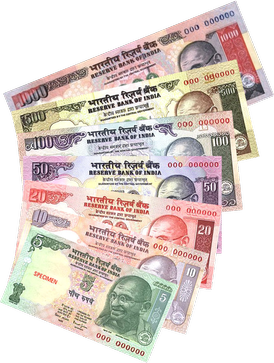
(Photo : Rupee--Wikipedia)
- The Indian rupee has weakened below the 84.50-per-dollar level for the first time ever due to the greenback's post-U.S. election rally and foreign investors' withdrawal.
- Despite the Reserve Bank of India's (RBI) interventions, the rupee has weakened nearly 0.5% in November.
- The RBI's interventions have led to the rupee's overvaluation against the currencies of India's major trading partners.
- The rupee's depreciation to an all-time low is a result of a confluence of factors, including the strengthening of the US dollar, domestic sell-offs, rising crude oil prices, and geopolitical uncertainties.
The Indian rupee has been under significant pressure, weakening below the psychologically important 84.50-per-dollar level for the first time ever. This historic low, recorded on Friday, is attributed to the resurgence of the greenback's post-U.S. election rally and the continued withdrawal of foreign investors from domestic equities and bonds. The rupee's depreciation to 84.5025 surpassed the previous all-time low of 84.4925, which was hit on Thursday.
Despite the Reserve Bank of India's (RBI) routine interventions, the rupee has weakened nearly 0.5% so far in November. In comparison, its Asian peers have lost between 0.9% to 2.2% this month. The dollar's strength has been bolstered by Donald Trump's U.S. election victory, with overseas investors pulling out over $4 billion from local equities and debt, causing a significant impact on the rupee.
The Dollar's Rally and Its Impact
The dollar index rose to a peak of 107.18, its highest in over a year, and has rallied more than 3% since Trump's victory on November 5. This rally is based on bets that the President-elect's policies could reignite inflation and temper future U.S. rate cuts. The gains paused earlier in the week but restarted on Wednesday due to heightened geopolitical risks and after Federal Reserve officials signaled caution on rate cuts. This global scenario has created a depreciating bias for currencies worldwide, including the Indian rupee.
However, the RBI's interventions, supported by India's healthy foreign exchange reserves, have been instrumental in keeping rupee volatility in check. State-run banks, on behalf of the RBI, have been offering dollars, with traders pointing to especially strong offers near the 84.50 level. A senior trader at a state-run bank noted that there is limited interest from interbank traders in selling dollars and very muted inflows, so the central bank will likely stay active to smoothen sharp moves.
RBI's Interventions and Market Reactions
The RBI's interventions, while aimed at ensuring the market is liquid and deep and functioning in an orderly manner, have led to the rupee's overvaluation against the currencies of India's major trading partners. Its 40-currency real effective exchange rate (REER), a measure of its competitiveness, shows the currency was overvalued by 7.21% at the end of October, according to RBI data.
The rupee's depreciation was further exacerbated by a massive sell-off in domestic equity markets and rising crude oil prices amid geopolitical uncertainty. The rupee opened at 84.41 at the exchanges and touched its lowest-ever level of 84.51 against the US dollar during the intraday. The session ended at 84.50 against the dollar, surpassing its all-time low of 84.46 on November 14.
The US dollar strengthened as global investors continue to buy the currency in search of a safe haven amid escalating tension between Russia and Ukraine. The continuous outflow of foreign funds also added to the woes of the Indian rupee. The Foreign Portfolio Investors (FPI) pulled out approximately USD 4 billion from Indian markets in November, following a record USD 11 billion outflow in October.
Market Dynamics and Future Outlook
The dollar index, which gauges the greenback's strength against a basket of six currencies, was trading lower by 0.02 per cent at 106.66. Brent crude, the global oil benchmark, surged by 1.84 per cent to USD 74.15 per barrel in futures trade. In the domestic equity market, the 30-share BSE Sensex tumbled 422.59 points, or 0.54 per cent, to close at 77,155.79 points, while Nifty tanked 168.60 points, or 0.72 per cent, to settle at 23,349.90 points.
In a similar vein, the share price of One 97 Communications, which operates the Paytm brand, declined ₹49.60 or 9.99% to trade at ₹446.65 on NSE. This was following the Reserve Bank Governor Shaktikanta Das's statement that the action on Paytm was driven by a "lack of compliance" at Paytm. Deputy Governor Swaminathan J added that the actions against the fintech have been taken due to "persisted non-compliance".









